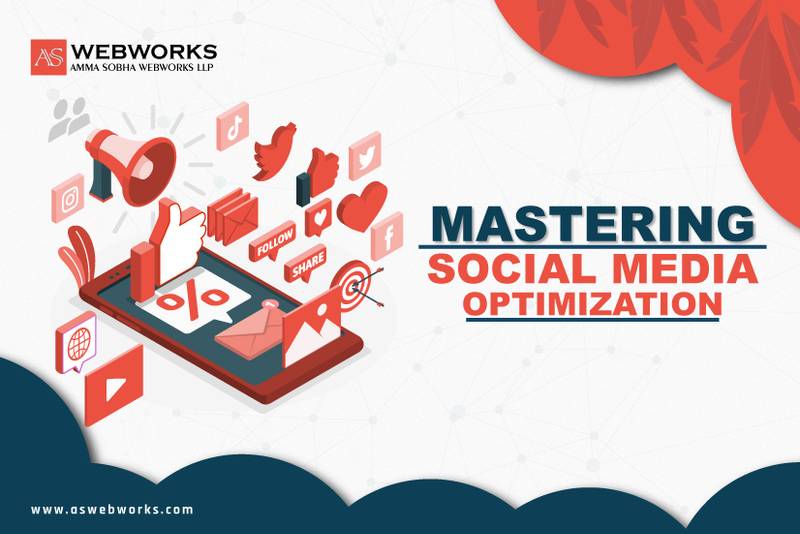In today’s digital age, social media reigns supreme as a powerful tool for businesses to connect with their target audience, build brand awareness, and drive growth. But simply having a social media presence isn’t enough. To truly thrive in the social media landscape, you need to understand and implement Social Media Optimization.
What Is Social Media Optimization (SMO)?
SMO is the strategic process of optimizing your social media presence to achieve specific goals. It involves creating and sharing engaging content, fostering interactions with your audience, and leveraging various social media features to maximize your reach and impact.
![]()
Think of it as the bridge between Social Media Marketing (SMM) and Search Engine Optimization (SEO). While SMM focuses on creating social media campaigns and strategies, SMO delves deeper into optimizing individual posts, profiles, and overall social media presence for better visibility and engagement.
Advantages Of Social Media Optimization (SMO):
1. Enhanced Brand Visibility:
SMO enables businesses to amplify their brand visibility across various social media platforms. By optimizing profiles, sharing engaging content, and fostering active engagement, businesses can reach a wider audience and increase brand awareness.
2. Increased Website Traffic:
Effective SMO strategies drive traffic from social media platforms to the company’s website. By sharing valuable content, promotions, and updates, businesses can attract visitors who are interested in their products or services, thereby boosting website traffic and potentially leading to conversions.
3. Improved Customer Engagement:
Active engagement on social media fosters meaningful interactions with customers. By responding to comments, messages, and mentions, as well as initiating conversations and soliciting feedback, businesses can build trust, loyalty, and long-term relationships with their audience.
4. Cost-Effective Marketing:
SMO offers a cost-effective alternative to traditional marketing channels. With minimal investment, businesses can create and share content, engage with their audience, and promote products or services on social media platforms, reaching target audiences without the hefty price tag associated with traditional advertising.

5. Enhanced Targeting and Segmentation:
Social media platforms offer robust capabilities for targeting and segmenting audiences, enabling businesses to connect with precise demographics, interests, and behaviours. By leveraging advanced targeting features, businesses can tailor their content and promotions to resonate with their target audience, increasing the effectiveness of their SMO efforts.
6. Real-Time Feedback and Insights:
SMO provides businesses with real-time feedback and insights into audience preferences, sentiments, and behaviours. By monitoring engagement metrics, tracking social media mentions, and analyzing audience interactions, businesses can gain valuable insights to refine their SMO strategies and optimise their content for maximum impact.
7. Competitive Advantage:
Sustaining a dynamic and compelling presence on social media can offer businesses a competitive edge. By staying connected with their audience, monitoring industry trends, and responding swiftly to market changes, businesses can position themselves as industry leaders and stay ahead of the competition.
8. Brand Loyalty and Advocacy:
Effective SMO strategies can cultivate brand loyalty and advocacy among customers. By delivering consistent value, fostering genuine connections, and providing exceptional customer experiences, businesses can turn satisfied customers into brand advocates who promote their products or services to their networks, further expanding brand reach and influence.
Challenges Of Social Media Optimization:

1. Content Relevance and Variety:
Crafting content that resonates with your target audience is essential. However, maintaining a balance between promotional and value-driven content can be challenging. Users seek diverse and engaging content, and repetitive posts can lead to disinterest.
Solution:
Create a content calendar that includes a mix of blog highlights, user-generated content, polls, quizzes, and multimedia elements like images and videos. This variety keeps your feed dynamic and caters to different preferences.
2. Algorithm Changes:
The importance of Social media algorithms is dynamic and subject to frequent updates. These changes can impact the visibility of your blog posts, making it challenging to maintain consistent reach and engagement levels.
Solution:
Stay updated on platform algorithm changes, adapt your strategy accordingly, and consider investing in paid promotions to ensure a steady flow of visibility for your blog.
3. Audience Fragmentation:
Different social media platforms attract diverse demographics. Tailoring content to suit the preferences of each platform’s user base while maintaining a consistent brand message can be challenging.
Solution:
Conduct audience research to understand the demographics and preferences of each platform. Customize your content strategy accordingly, ensuring it aligns with the expectations of users on each platform.
4. Evolving Trends:
Social media marketing trends evolve rapidly, and staying ahead of the curve can be demanding. Failing to adapt to emerging trends may result in your blog appearing outdated or less appealing.
Solution:
Regularly monitor industry trends and incorporate relevant ones into your content strategy. Experiment with new formats, such as live videos, stories, and reels, to keep your content fresh and aligned with current user preferences.
5. Competition for Attention:
The sheer volume of content vying for users’ attention poses a significant challenge. Standing out in a crowded digital landscape requires creativity and strategic planning.
Solution:
Develop eye-catching visuals, compelling headlines, and concise captions to capture attention quickly. Consistently deliver high-quality content that adds value to your audience’s feed, fostering a sense of loyalty.
6. Building a Community:
Establishing a genuine and engaged community around your blog can be time-consuming. Encouraging meaningful interactions and fostering a sense of belonging among your followers requires careful cultivation.
Solution:
Respond promptly to comments, actively participate in discussions, and host interactive sessions like Q&A sessions or polls. Building a community takes time, but the trust and loyalty gained are invaluable.
Beyond The Basics: Advanced SMO Techniques:
For those seeking to take their SMO game to the next level, here are some advanced techniques to consider:
- Social Listening:
Actively listen to online conversations about your brand, industry, and competitors to gain valuable insights and inform your content strategy.
- Influencer Marketing:
Partner with relevant influencers in your niche to reach a wider audience and leverage their credibility.
- Paid Social Media Advertising:
Utilise paid advertising options on social media platforms to target specific demographics, interests, and behaviours, potentially reaching a larger audience and boosting engagement.
- Utilise Social Media Management Tools:
Many online tools can help you schedule posts, manage multiple accounts, track analytics, and engage with your audience more efficiently.
Conclusion:
In the ever-evolving landscape of social media, mastering the art of Social Media Optimization is essential for anyone seeking to thrive online. By strategically optimising profiles, crafting compelling content, and leveraging advanced strategies, individuals and businesses can create a powerful digital presence that resonates with their target audience.
Implement these SMO techniques consistently, adapting them to the changing dynamics of social media platforms, and watch as your online presence flourishes. Stay engaged, stay authentic, and unlock the full potential of social media for your brand or personal endeavours.

